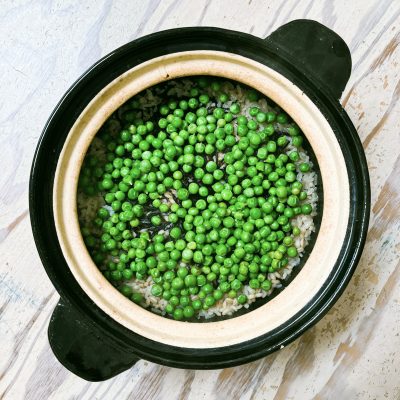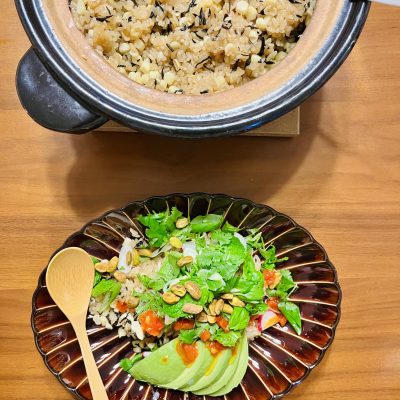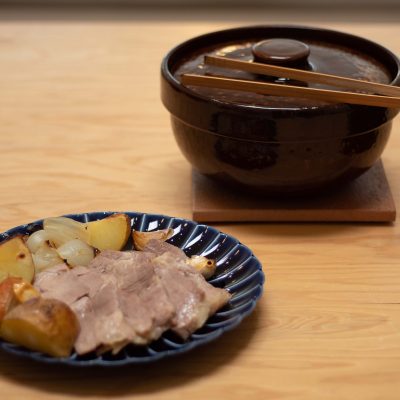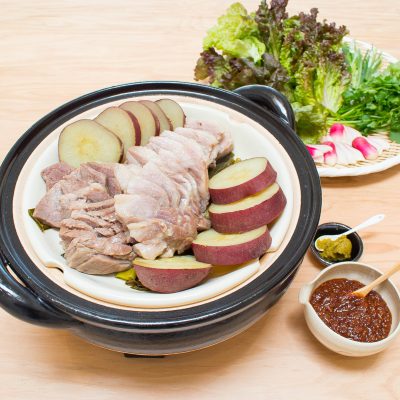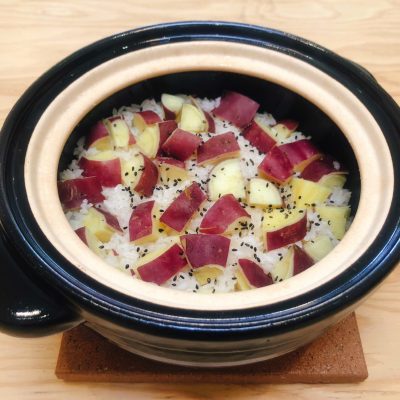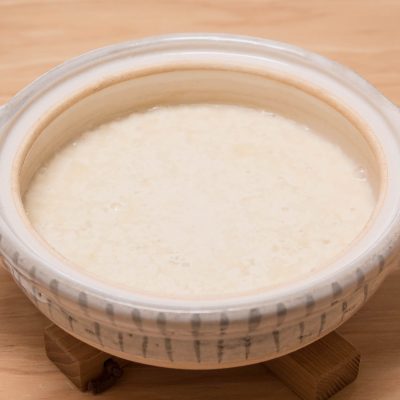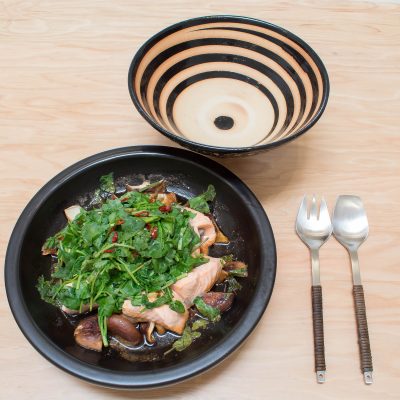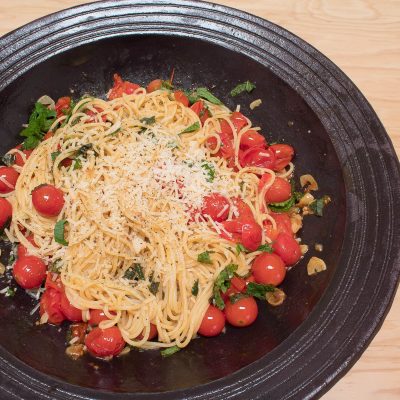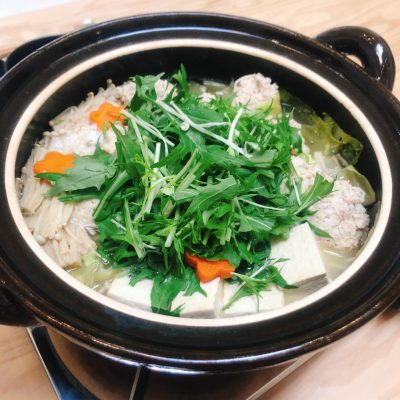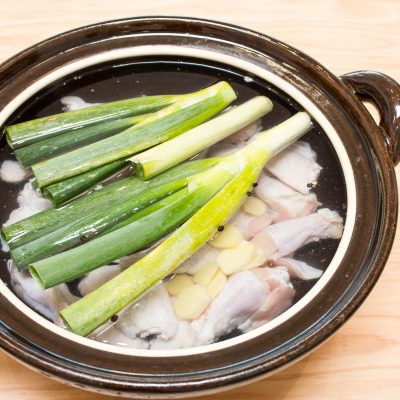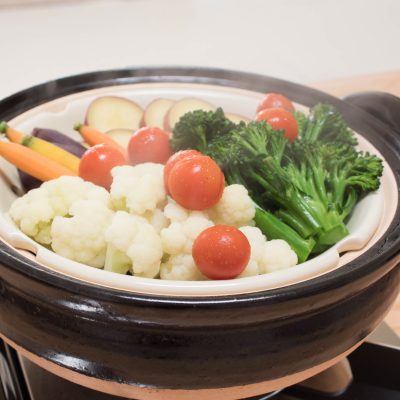I can’t get enough of fresh English peas in the spring time. Here’s a slightly different version (and I would say even easier version) of my original English Peas and Hijiki Rice recipe, and this is equally delicious! Instead of using dashi stock, I add a content of a Vegetable Dashi packet directly to the water. The result is really umami rich and aromatic rice. Mochi Mugi barley adds nice texture and flavor, too. If you can’t find shelled fresh English peas, you can use frozen kind by thawing them before adding to the donabe.
Tag Archives: Sea salt
Corn & Hijiki Rice with Olive Oil
This donabe dish is a variation of my other corn rice recipes and has been a big hit! This is 100% vegan and its flavor is really rich with corn, and fresh and aromatic with the addition of the extra virgin olive oil and mixed herbs. This dish makes a great one plate meal and tastes great at a warm or room temperature. Happy Donabe Life!
Sea Bream Rice
One of my favorite dishes to eat during the spring is Tai Meshi (Sea Bream Rice), made in a donabe. I cook the rice with a whole Tai (sea bream), so it’s not only very flavorful but the dish is perfect for festivity. I usually cook this dish with my double-lid donabe rice cooker, Kamdo-san, but since the fish I got this time was much bigger than my 3 rice-cup size Kamado-san, I decided to make it in my large-size donabe (I used my donabe steamer, Mushi Nabe, without the steam grate). By bending its tail, I could barely fit it in my donabe! To garnish, kinome (sansho leaves) are typically used in Japan. But since it’s hard to find kinome here in LA, I used dill and it paired with the rice beautifully.
Roasted Salt-Marinated Pork
This is a basic, and also my favorite recipe using Roast Donabe. This extra-durable donabe is thick-bodied with a sturdy flat lid which can tight seal. And, it’s quite handy. You can simply set your choice of ingredients on the roast grate, and set the donabe (with the lid on) over gas stove to roast. The cooking time can vary depending on the type of ingredients, and it’s easily adjustable. By lining the bottom with a piece of aluminum foil (although it’s optional), it can catch all the drippings from ingredients during cooking and make the cleaning very after use.
This donabe is also great for slow cooking such as stew, braising, or oven roasting. I love this donabe so much, because with such a minimum work, I can make the really amazing roasted pork etc. and can also make my guests excited.
Steamed Moshio-Salt-Marinated Pork Shoulder
This dish was inspired by a popular Korean dish, bossam, which I love. In bossam, boiled pork belly block is sliced and served with condiments, and you can make a wrap with a napa cabbage leaf. In my version, I start with a pork shoulder block and marinade it with Moshio (seaweed sea salt) for overnight to a full day. If you don’t have moshio, you can use other kind sea salt, but moshio really makes the flavor so rich and complex, and also tenderize the meat very well. The meat is, then, steamed in donabe, and sliced to serve with lettuce leaves and condiments. You can make it with pork belly, too.
This dish is so simple to make and is also real fun dish to share at a table. All you have to do for cooking is simply put a block of salt-marinated pork shoulder in the Mushi Nabe, and steam for about 30 minutes or until done. When you are entertaining guests, you can pre-cook the meat in advance, and just reheat in the donabe before service. If you slice the meat in front of the guests, it will bring out more excitement. Then, at the table, you can have lettuce and condiments ready, and everybody can make his/ her own wraps. The meat is so tender and flavorful, and it’s pretty hard to stop eating once you start.
Japanese Sweet Potato Rice
This is one of my favorite fall-to-winter rice dishes since I was a child. This is such a simple dish, as the main ingredients are just the rice and satsuma-imo (Japanese sweet potato), and they are seasoned very lightly only with salt. The natural sweetness of the satsuma-imo is fully brought out after cooked with the rice, and the texture is nicely soft to work great with the shiny chewy rice. I also love making onigiri (rice balls) with this dish. They taste great hot or room temperature. If you want to add more flavor, you can cook the rice with dashi or even consommé works nicely, too.
Homemade Tofu
Authentic fresh tofu can be made at home very easily, once you have a donabe and high quality soymilk. All you need to do is to heat soymilk, stir in nigari liquid, turn off the heat, and rest until the mixture sets to become tofu. Iga-yaki donabe is perfect for fresh tofu making, because the porous body achieves the gentle and even heat distribution. It also cools down very slowly after turning off the heat, so the tofu can set to ideal stage during the resting time. The fresh warm tofu right out of donabe is simply a joy and I always have my first few tastes without any seasonings or condiments. It’s so fluffy, delicate, and pure. Then, I enjoy it with different toppings. Sometimes simply with shaved katsuobushi (shaved dried bonito flakes) and soy sauce, or wasabi, sea salt (such as moshio sea salt), and sesame oil. Ponzu is great, too.
Premium quality Banrai Soymilk and Banrai Nigari Liquid are both available at our shop. So, hope you give it a try. You can make a full-size sukui tofu to share or a small individual-size tofu in a mini-size donabe for everyday breakfast.
The recipe introduced in this page is calling for 1-liter soymilk. For the half amount, you can use a small-size classic-style donabe (approx. 0.8-qt/ 800 ml size). The photos below are made with small-size Rikyu-Tokusa donabe.
For an idividual-size silky tofu making method, please see Banrai Soymilk and Banrai Nigari Liquid product page.
Tomato Ginger Rice
Half-cut tomatoes are cooked together with rice in the donabe and becomes an extremely luscious dish. Tomatoes break so easily with a rice paddle and once you gently mix the contents, the beautiful red color coats the rice and imparts the sweet aroma of tomatoes and ginger. While this dish is completely vegan, even my meat-loving friends go crazy over it. (And, they fight over Naosco, the Yuzu-Kosho flavored hot sauce I make as a condiment for this dish.)
I love making this dish while the tomatoes are in season during summer. But, tomatoes don’t have to be very ripe to make this dish, so you can enjoy making this dish any time of the year.
Salmon, Shiitake and Watercress in Smokey Garlic Black Vinegar Sauce
With just three main ingredients (salmon, shiitake mushrooms, and watercress) and simple preparation, this sizzling dish makes a very satisfying meal. The garlic black vinegar flavor is further enhanced with smoked soy sauce, but if you don’t have it, you can make it with regular high quality soy sauce, too. Make sure to drink up any remaining sauce, or dip some freshly-cooked donabe rice, as it’s so tasty.
Shichimi-Flavored Cherry Tomato & Mint Pasta
When the cherry tomatoes are slowly heated with garlic and blistered in the oil in donabe, the flavor becomes even more bright and perfectly juicy. Once the tomatoes are blistered, all you need to do is just add the spaghetti, and toss with some mint. Finish with shaved Parmesan cheese and a generous amount of Shichimi Togarashi to enjoy. This simple dish is so rich and flavorful. I always have a hard time to stop heating it.
Chirashi Sushi with Soy-Marinated Tuna
This dish is very easy to make and always a crowd pleaser. Once you get a block of very fresh tuna, all you have to do is to make sushi rice, slice and marinade tuna, get other small components ready and just assemble. The marinating time of tuna should be just up to 15 – 20 minutes. If it’s marinated too long, it will start to “cook” the tuna and the color could get a bit too dark. I like to make the sushi rice by adding 16 Multi Mixed Grains for more complex flavor, texture, and beautiful color in the sushi rice, but you can make it without, too. Whenever I make this dish for friends, it disappears in a matter of moments!
Salt Butter Chanko Hot Pot
Japanese sumo wrestlers cook and eat chanko nabe at their stable every day. That’s the source of their strength. While chanko nabe refers to any types of hot pot eaten by sumo wrestlers, the most typical style is chicken as a main protein and cooked in chicken broth. It’s because chicken stands on two legs like human beings, so it is considered to bring good luck (in sumo, you lose if your hands touch the ground). Chanko nabe typically makes a very nutritious and balanced meal, as you cook a wide variety of healthy ingredients in one pot. The sumo wrestlers are big, because they eat so much of it every meal! In my version, I cook chicken meatballs and vegetables in simple salt-flavored chicken broth, and add butter cubes right before serving. The aroma is so irresistible and the flavor is superb. As a shime (finishing course), I suggest ramen noodles to cook in the remaining broth.
Matcha & Salt Madeleine
This one-pot donabe madeleine is always so tasty and it’s hard to stop eating it. I make it with Bistro Donabe, as its extra thick body and the flat bottom allow the heat to distribute gently and also make a nice presentation when it’s sliced. The authentic matcha flavor is complemented with the mineral-rich moshio sea salt. When I serve this with freshly-whisked matcha, I’m in heaven.
Japanese Chicken Stock
Relatively inexpensive chicken wings can make really rich and flavorful stock, as the wings have a lot of bones and joints where the richest flavors are released from. In just 20 minutes of simmering plus resting time, the rich tori dashi is ready. I usually make a large amount, so I can use it for a couple of different dishes, but if your donabe is medium or smaller size, you can adjust the recipe about by cutting by half or so. The bonus of making this stock is the leftover chicken. It’s still flavorful, so I like to make a side dish with it.
Steamed Vegetables (Basic Steaming)
When I first tried simple vegetables steamed in Mushi Nabe, I was so surprised how pure and delicious they tasted. Mushi Nabe cooks vegetables fast and really brings out their natural flavors well. All I need to do is just get the seasonal high quality vegetables I like and steam in Mushi Nabe. Try those vegetable simply with a quick dipping sauce of some sea salt and extra virgin olive oil, or your choice of dipping sauce.

